Introduction
The republic of Haiti occupies the western portion of the island of Hispaniola. It shares this end of the island with the Dominican Republic. A significant percentage of the country’s citizenry is made up of Latinos. The population of this group has been growing rapidly over the years. The increase has affected the nation both negatively and positively. Latinos are individuals who are originally from Latin America.
The state of the foreign-born Latinos in Haiti is influenced by different factors. They include immigration and policies put in place by the government. The current population of foreign-born individuals in Haiti stands at 48,973 (Tovar et al. 360). The figure is equivalent to 61.7% of the total population. The number of native Latinos in Haiti is 30,392. It is equivalent to 38.3% of the population. The figure shows that the number of foreign-born Latinos in the region is higher than that of their native counterparts. According to demographic reports, the immigrants are engaged in both high-skill and low-skill jobs in the labor market.
In this paper, the author will analyze the state of foreign-born Latinos in Haiti. The author will, among others, highlight the representation of this group in the general population and in the labor market. Their contribution to the socio-economic sector of the Haitian society will also be reviewed.
Foreign-Born Latinos in Haiti
Haiti is a low developed country. It is one of the poorest nations in the Americas. The population of this region is also lower compared to that in other nations in America. The presence of a high number of foreign Latinos in the region can be attributed to the historical backgrounds of the nations the immigrants come from. Haiti has encountered numerous natural calamities that have claimed the lives of many people in the region (Elo, Vang, and Culhane 2372).
An example is the 2010 earthquake. Many foreign Latinos died in the tragedy. However, their number in the region still remains high. The economy of Haiti cannot support the entire population. In spite of this, the availability of jobs is regarded as the main thing that has influenced people to move into the nation. The graph below shows the participation of foreign-born Latinos in the labor force by age, sex, and ethnicity as of 2011:

Age Distribution
The age distribution of foreign-born Latinos in Haiti is shown in figure 2 below. The median age of this group is 42 years. That of non-citizens in the country is 39 years. The figures show that the number of old persons in Haiti is high. Having many aged persons in a country is a threat to the economy. The fact that this group is large shows that the economy is growing at a slow pace. The majority of aged persons cannot work effectively to build the economy.
Most of them are retired and are not engaged in any economic activity. On the contrary, the youth have a significant impact on the economy, especially when it comes to the development of a nation (Elo et al. 2375). A figure of 73% is high for old people in the society. The fact that the youth make up only 27% of the population is an indication of a dormant economy.
Marital Status of Foreign-Born Latinos in Haiti
The graph below shows the marital status of foreign-born Latinos in Haiti from 1970 to 2009:
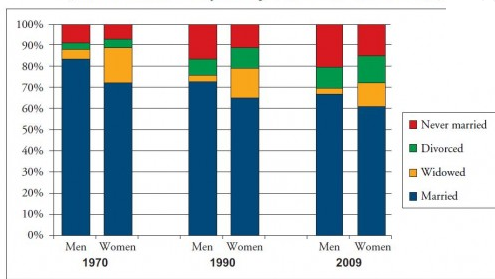
The number of married foreign Latinos stands at 24,687. The figure is equivalent to 53% of the total population. Native Latinos make up 47% of married individuals. The reason for the high number of married Latinos in Haiti is the increased rate of immigration. A rise in the number of marriages has led to an increase in population. However, due to poor economic conditions, the country records high mortality rates among infants and mothers.
The deaths are largely attributed to poor medical care. The fact that there are many married foreign Latinos in Haiti is not a guarantee that they live under good conditions. If the economy of the nation was better, then it would be easier for the Latinos to take good care of their families (Elo et al. 2376). Population growth in Haiti continues to suppress the economy of the nation. The high population of Latinos in the nation would be advantageous if only the economy would be able to sustain them.
Most people in Haiti, especially foreign Latinos, receive a lot of support from the United Nations. Food and medicine are some of the effects that the country receives to boost its economy. Many marriages in Haiti do not pull through as a result of poverty. Even though many foreign Latinos in the country get married, supporting their families becomes difficult due to a lack of income. The economy is stagnant at the moment but the humanitarian caregivers are making efforts to help it grow.
The migration of Latinos into Haiti has various positive impacts on the nation. The growth of this population creates labor for the few industries coming up in the region (Elo et al. 2380). The presence of quick and cheap labor is important in the process of building the economy. The high number of foreign Latinos in Haiti has made it possible for many industries to grow. It is noted that some of the immigrants in this country possess relatively high levels of skills.
The presence of highly skilled foreign Latinos plays a major role in the development of the economy. The data touching on age and marital status clearly shows how the economy of the region is affected by foreign Latinos.
Education of Foreign-Born Latinos in Haiti
Education is an important aspect of the economy. The number of educated people within a certain region gives an overview of how the economy is expected to behave in the next few years. In Haiti, the number of foreign Latinos with education below the level of high school is 7,055. The figure translates to 17.3% of the total population (Kritz, Gurak, and Lee 528). It represents those people in society who lack the skills needed to build the economy.
The number of foreign Latinos with high school education is 13,550. The figure represents 33.2% of the total population. From the data, one can conclude such persons are capable of helping in different ways to build the economy of Haiti (Kritz et al. 528). The number of people who have attended college for a diploma or any other certificate course is 10,899. The figure is equivalent to 26.7% of the country’s total population.
The number of foreign Latinos with a bachelor’s degree and above is 9,278. The figure represents about 22.8% of the total population of foreign Latinos in Haiti. The total population and the data indicated are made up of both citizens and non-citizens. The number of native-born Latinos who have attained education between high school and bachelor’s level is 5,137 (Kritz et al. 530). It is only 11.2% of total Latinos in Haiti. From the figures, it is clear that the immigration of foreign-born Latinos into Haiti is of benefit when it comes to education. The graph below represents this information:
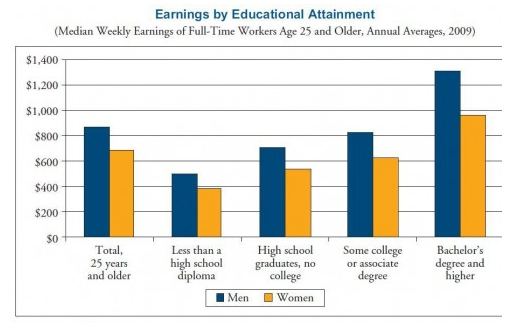
From the data, it is clear and evident that most of the foreign Latinos in Haiti are educated. Only 17.3% of the total population can be termed as not properly educated. Consequently, it is a fact that a large number of Latino immigrants in the region are educated. However, the number of job opportunities is low. Some of these immigrants move to the area in search of employment (Kritz et al. 530). The economy of Haiti cannot sustain all these educated people in the job industry. As a result, unemployment in the region cannot be a result of a lack of education. The benefits of the education system can only be felt in the nation if the job market can sustain both natives and foreign Latinos.
Participation in the Labour Force
The importance of foreign-born Latinos in Haiti can be seen in their participation in the labor force. The element can tell how much a group of people is involved in growing the economy of a certain region. The number of foreign-born Latinos (both citizens and non-citizens) amounts to 34,714 persons. The number is high compared to that of native Latinos (Tovar et al. 358). The participation of foreign-born Latinos in the labor market stands at 75% of the total population. That of native-born Latinos is 25%.
The number of individuals involved in the labor market can tell the importance of foreign-born Latinos when it comes to the growth of the economy. The figures show that the economy of Haiti depends a lot on the labor of these individuals. The figures concerning education attainment also show that foreign-born Latinos are more educated than their native counterparts (Tovar et al. 359).
As a result, it is easy for them to offer their labor to the economy because they are equipped with a number of skills, unlike the natives. Education is a motivation with regard to participation in labor. The economy of Haiti is assisted to a large extent by foreign-born Latinos who provide their labor. The graph below shows the participation of foreign-born Latinos in the country’s labor market for 2010 and 2012. Their engagement is compared to that of natives:
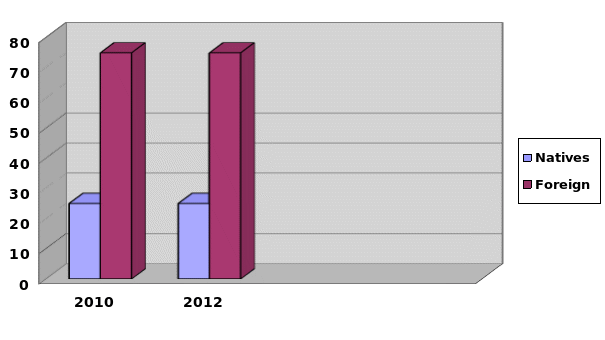
Unemployment
The figures above on labor force participation in Haiti provide more information with regards to unemployment in the region. The number of unemployed foreign-born Latinos in Haiti is 5,729. The figure represents 16.5% of the total population of both citizens and non-citizens. The number of unemployed natives in the country is 2,491. The figure represents 28.3% of the population. By comparing the two figures, one can conclude that the highest number of unemployed is made up of natives. The difference in the figures is brought about mainly by the aspect of education. The educated natives are fewer than the foreign Latinos and this translates to the unemployment rates (Tovar et al. 359).
From the figures, it can be stated that there is an equal distribution of employment opportunities in Haiti. Equal distribution is important to the growth of an economy. In unequal distribution, the natives would have more employment opportunities even though their number is down in terms of education. The figures on unemployment in Haiti can change if the economy grows to accommodate and attract investors (Tovar et al. 359). The graph below relates to the data provided on unemployment and labor force in Haiti:
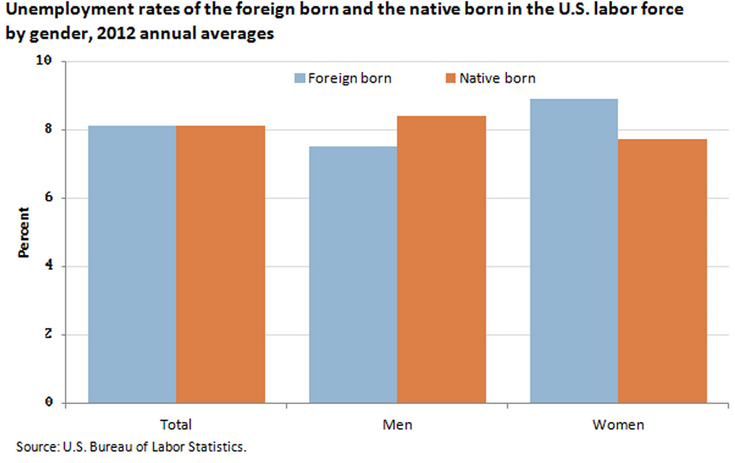
Occupation among Groups
Foreign Latinos in Haiti take up different jobs. The population is concentrated in white-collar and blue-collar jobs. The group is also represented in the service sector. Most foreign-born Latinos in Haiti are involved in the service sector. To this end, 60% of these individuals are in the service segment. 15% take-up blue collar jobs, while 25% are involved in white collar employments. According to the figures, job opportunities in the service sector are many.
It is rare to find blue-collar jobs. White-collar opportunities are more than blue-collar jobs (Manuel, Taylor, and Jackson 228). Earnings in the different sectors tell the effects of the occupational groups on the economy of the nation. Many people may be involved in the service industry. However, the payment here may be poor. Many natives are also in the service industry. It shows that this sector has both foreign and native Latinos.
Earnings
The earnings of the employed persons in Haiti clearly show how people are affected by the economy and unemployment. White-collar jobs in Haiti offer 64.7% of the total earnings. Blue-collar jobs take up 14.1% of the total wages. The service has the largest number of people. However, it offers the lowest wages in the three job categories. Service jobs involve educated people in society. What this means is that they should be paid more. The economy of Haiti, however, cannot be compared to that of other states in America. It is still growing and it cannot offer high earnings to many people within the largest occupation group. It shows that even though foreign-born Latinos are more educated and are willing to provide more labor in the market than other people, they have not rewarded accordingly (Manuel et al. 228).
Earnings are determined by the economy and not by the employer. Economic circumstances force institutions to set minimum and maximum wages at certain levels (Manuel et al. 228). The graph below illustrates the data given about the earnings of Latinos in Haiti for 2012:
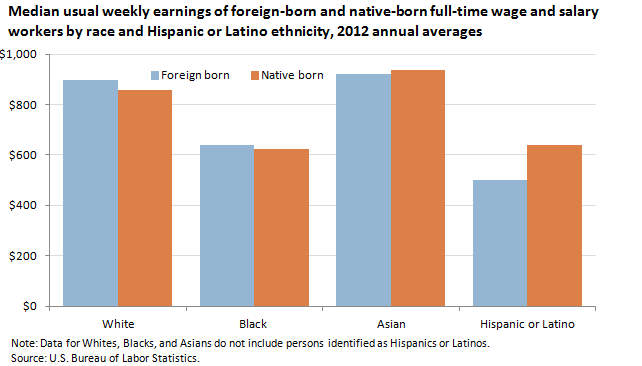
Medical Insurance
The last measure of the status of foreign-born Latinos in Haiti is medical insurance. It is noted that 10% of the total population has medical insurance. The remaining 90% do not have. The same case applies to natives in Haiti (Tovar et al. 359). Foreign-born Latinos (both citizens and non-citizens) are not properly rewarded for their social, economic, and political efforts towards the development of the country. Most of the companies that are associated with recruiting and employing workers have a responsibility to insure them. However, the statistics show that only a few workers enjoy insurance benefits. The figures on earnings show that foreign-born Latinos do not fully enjoy their salaries. Their earnings are low. However, this cannot be blamed on the employer.
The economy determines what a company can pay its workers and what types of benefits they can enjoy (Tovar et al. 358). The economy of Haiti is still growing and most employers want to make profits. It will be difficult for them to offer insurance benefits and high salaries and still expect to make profits. The graph below represents the percentage of native and foreign-born Latinos provided with medical insurance in Haiti between 2010 and 2012:
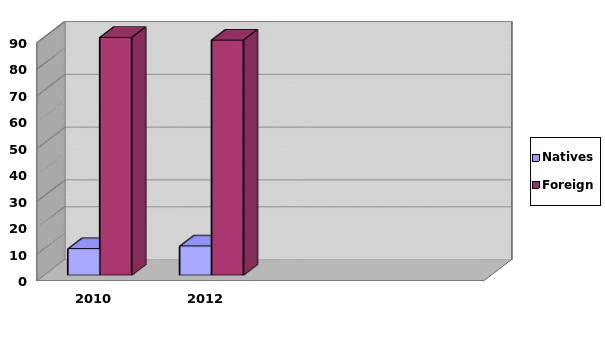
Conclusion
From the figures above, one can tell how foreign-born Latinos in Haiti are affected by different aspects of the economy. The population of these individuals in other nations is affected differently by prevailing situations. The variations depend on the state of the economy. The economy of Haiti has faced a number of setbacks. It is still developing. Consequently, it cannot sustain all individuals as expected. In light of this, it is not surprising to find low earning workers in the country. High rates of unemployment are also reported among these groups. Development affects the economy negatively.
Works Cited
Elo, Irma, Zoua Vang, and Jennifer Culhane. “Variation in Birth Outcomes by Mother’s Country of Birth among Non-Hispanic Black Women in the United States.” Maternal and Child Health Journal 18.10 (2014): 2371-2381. Print.
Kritz, Mary, Douglas Gurak, and Min-Ah Lee. “Foreign-Born Out-Migration from New Destinations: Onward or Back to the Enclave?.” Social Science Research 42.2 (2013): 527-546. Print.
Manuel, Ron, Robert Taylor, and James Jackson. “Race and Ethnic Group Differences in Socioeconomic Status: Black Caribbeans, African Americans, and Non-Hispanic Whites in the United States.” The Western Journal of Black Studies 36.3 (2012): 228. Print.
Tovar, Alison, Aviva Must, Nesly Metayer, David Gute, Alex Pirie, Raymond Hyatt and Christina Economos. “Immigrating to the US: What Brazilian, Latin American, and Haitian Women have to say about Changes to their Lifestyle that may be Associated with Obesity.” Journal of Immigrant and Minority Health 15.2 (2013): 357-364. Print.